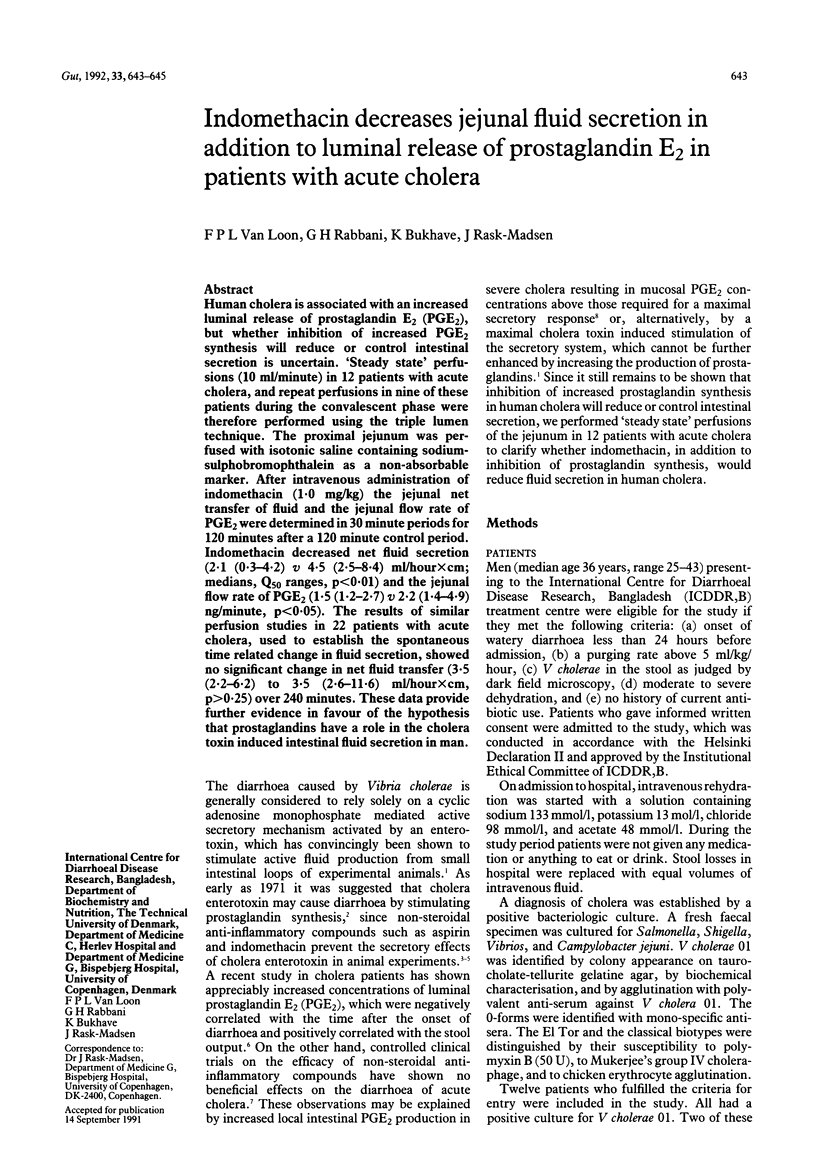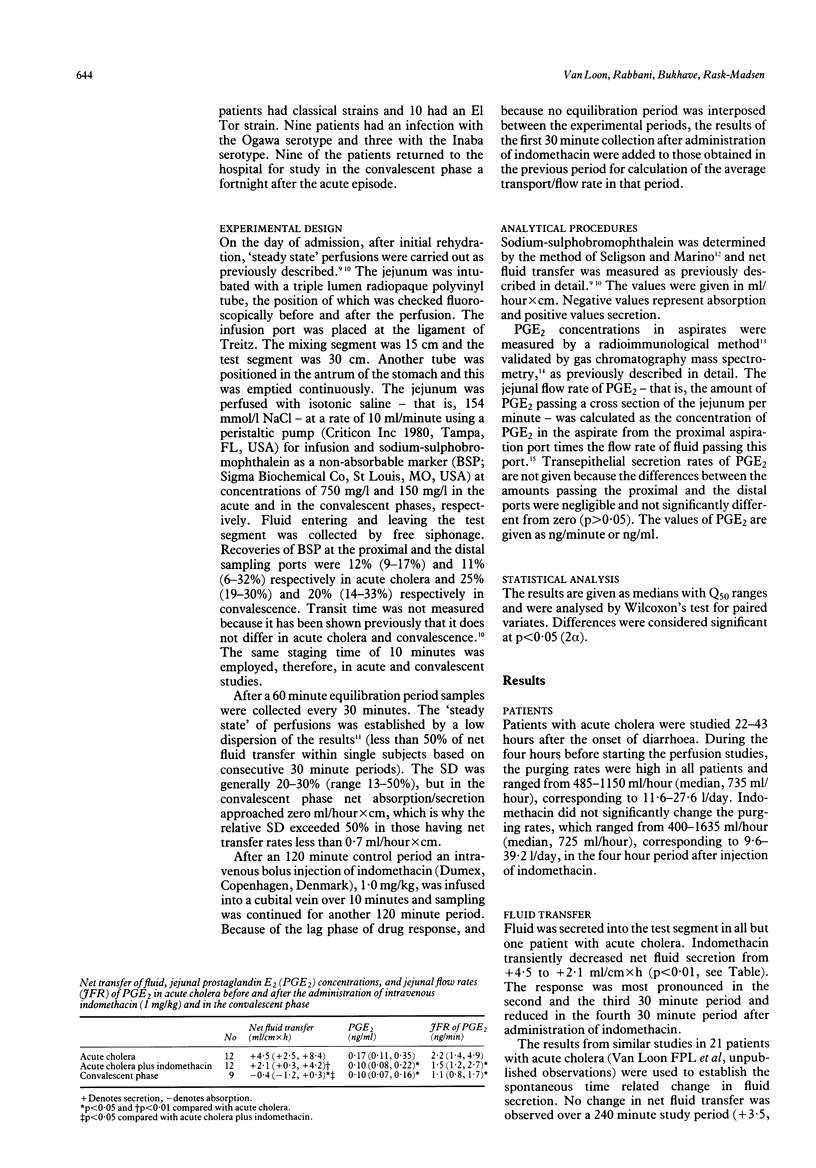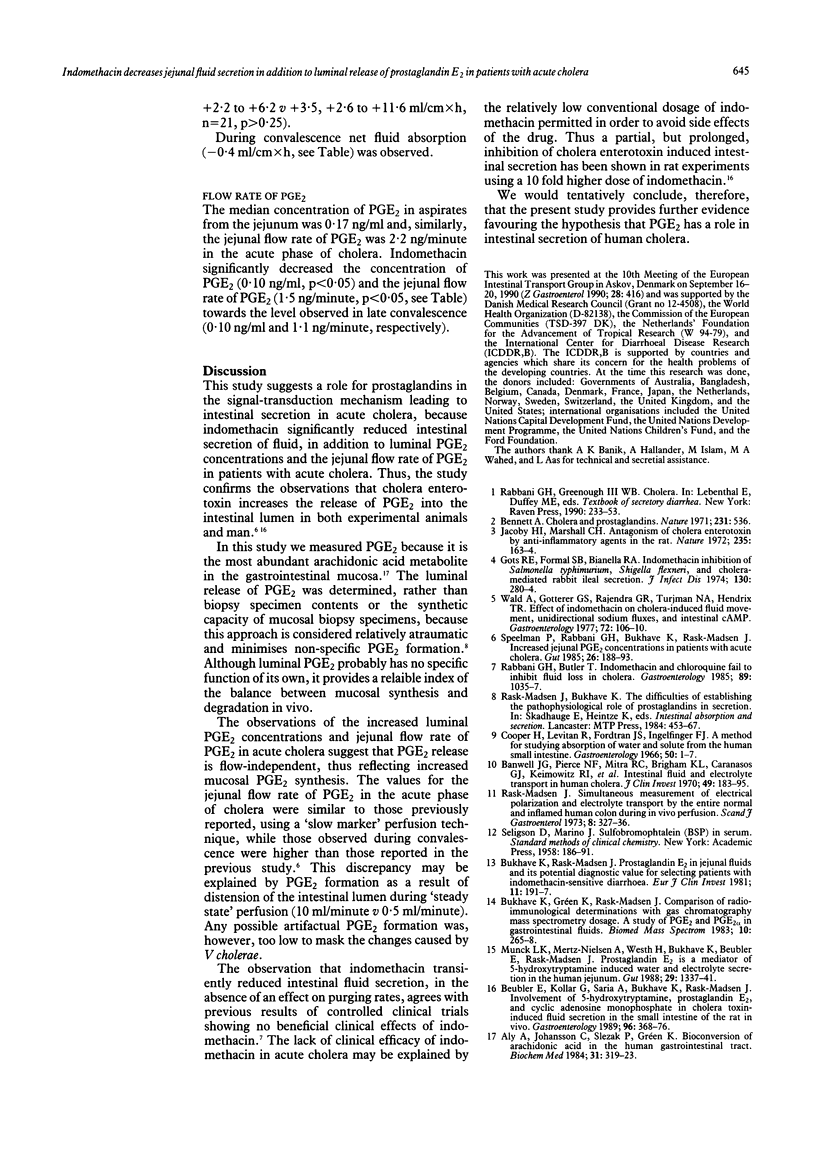Abstract
Human cholera is associated with an increased luminal release of prostaglandin E2 (PGE2), but whether inhibition of increased PGE2 synthesis will reduce or control intestinal secretion is uncertain. 'Steady state' perfusions (10 ml/minute) in 12 patients with acute cholera, and repeat perfusions in nine of these patients during the convalescent phase were therefore performed using the triple lumen technique. The proximal jejunum was perfused with isotonic saline containing sodium-sulphobromophthalein as a non-absorbable marker. After intravenous administration of indomethacin (1.0 mg/kg) the jejunal net transfer of fluid and the jejunal flow rate of PGE2 were determined in 30 minute periods for 120 minutes after a 120 minute control period. Indomethacin decreased net fluid secretion (2.1 (0.3-4.2) v 4.5 (2.5-8.4) ml/hour x cm; medians, Q50 ranges, p less than 0.01) and the jejunal flow rate of PGE2 (1.5 (1.2-2.7) v 2.2 (1.4-4.9) ng/minute, p less than 0.05). The results of similar perfusion studies in 22 patients with acute cholera, used to establish the spontaneous time related change in fluid secretion, showed no significant change in net fluid transfer (3.5 (2.2-6.2) to 3.5 (2.6-11.6) ml/hour x cm, p greater than 0.25) over 240 minutes. These data provide further evidence in favour of the hypothesis that prostaglandins have a role in the cholera toxin induced intestinal fluid secretion in man.
Full text
PDF


Selected References
These references are in PubMed. This may not be the complete list of references from this article.
- Aly A., Johansson C., Slezak P., Gréen K. Bioconversion of arachidonic acid in the human gastrointestinal tract. Biochem Med. 1984 Jun;31(3):319–331. doi: 10.1016/0006-2944(84)90088-7. [DOI] [PubMed] [Google Scholar]
- Banwell J. G., Pierce N. F., Mitra R. C., Brigham K. L., Caranasos G. J., Keimowitz R. I., Fedson D. S., Thomas J., Gorbach S. L., Sack R. B. Intestinal fluid and electrolyte transport in human cholera. J Clin Invest. 1970 Jan;49(1):183–195. doi: 10.1172/JCI106217. [DOI] [PMC free article] [PubMed] [Google Scholar]
- Bennett A. Cholera and prostaglandins. Nature. 1971 Jun 25;231(5304):536–536. doi: 10.1038/231536a0. [DOI] [PubMed] [Google Scholar]
- Beubler E., Kollar G., Saria A., Bukhave K., Rask-Madsen J. Involvement of 5-hydroxytryptamine, prostaglandin E2, and cyclic adenosine monophosphate in cholera toxin-induced fluid secretion in the small intestine of the rat in vivo. Gastroenterology. 1989 Feb;96(2 Pt 1):368–376. doi: 10.1016/0016-5085(89)91560-6. [DOI] [PubMed] [Google Scholar]
- Bukhave K., Gréen K., Rask-Madsen J. Comparison of radioimmunological determinations with gas chromatography mass spectrometry dosage. A study of PGE2 and PGF2alpha in gastrointestinal fluids. Biomed Mass Spectrom. 1983 Apr;10(4):265–268. doi: 10.1002/bms.1200100406. [DOI] [PubMed] [Google Scholar]
- Bukhave K., Rask-Madsen J. Prostaglandin E2 in jejunal fluids and its potential diagnostic value for selecting patients with indomethacin-sensitive diarrhoea. Eur J Clin Invest. 1981 Jun;11(3):191–197. doi: 10.1111/j.1365-2362.1981.tb01840.x. [DOI] [PubMed] [Google Scholar]
- Cooper H., Levitan R., Fordtran J. S., Ingelfinger F. J. A method for studying absorption of water and solute from the human small intestine. Gastroenterology. 1966 Jan;50(1):1–7. [PubMed] [Google Scholar]
- Gots R. E., Formal S. B., Giannella R. A. Indomethacin inhibition of Salmonella typhimurium, Shigella flexneri, and cholera-mediated rabbit ileal secretion. J Infect Dis. 1974 Sep;130(3):280–284. doi: 10.1093/infdis/130.3.280. [DOI] [PubMed] [Google Scholar]
- Jacoby H. I., Marshall C. H. Antagonism of cholera enterotoxin by anti-inflammatory agents in the rat. Nature. 1972 Jan 21;235(5334):163–165. doi: 10.1038/235163a0. [DOI] [PubMed] [Google Scholar]
- Munck L. K., Mertz-Nielsen A., Westh H., Bukhave K., Beubler E., Rask-Madsen J. Prostaglandin E2 is a mediator of 5-hydroxytryptamine induced water and electrolyte secretion in the human jejunum. Gut. 1988 Oct;29(10):1337–1341. doi: 10.1136/gut.29.10.1337. [DOI] [PMC free article] [PubMed] [Google Scholar]
- Rabbani G. H., Butler T. Indomethacin and chloroquine fail to inhibit fluid loss in cholera. Gastroenterology. 1985 Nov;89(5):1035–1037. doi: 10.1016/0016-5085(85)90205-7. [DOI] [PubMed] [Google Scholar]
- Rask-Madsen J. Simultaneous measurement of electrical polarization and electrolyte transport by the entire normal and inflamed human colon during in vivo perfusion. Scand J Gastroenterol. 1973;8(4):327–336. [PubMed] [Google Scholar]
- Speelman P., Rabbani G. H., Bukhave K., Rask-Madsen J. Increased jejunal prostaglandin E2 concentrations in patients with acute cholera. Gut. 1985 Feb;26(2):188–193. doi: 10.1136/gut.26.2.188. [DOI] [PMC free article] [PubMed] [Google Scholar]
- Wald A., Gotterer G. S., Rajendra G. R., Turjman N. A., Hendrix T. R. Effect of indomethacin on cholera-induced fluid movement, unidirectional sodium fluxes, and intestinal cAMP. Gastroenterology. 1977 Jan;72(1):106–110. [PubMed] [Google Scholar]


